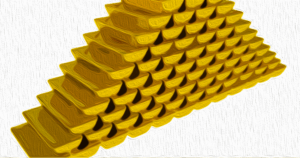
Introduction
Over the past few years, the stablecoin market has experienced significant turbulence, with several prominent stablecoins facing setbacks and declining supplies. In this article, we will explore the descent of Gemini's stablecoin GUSD, Paxos' USDP, and Abracadabra Money's MIM, and discuss the implications for the stablecoin market as a whole.
The Fall of GUSD
Gemini's stablecoin GUSD, once ranked as the ninth largest stablecoin by market capitalization, has seen a dramatic decline in its supply. Despite earning an A grade from the stablecoin rating firm Bluechip, GUSD lacks significant liquidity on exchanges and is not widely used in the crypto markets. Its market capitalization has plummeted by 93.10% from approximately $564.86 million to $38.93 million. GUSD's ranking has slipped to the 24th largest stablecoin and is currently placed 667th among 12,000 crypto assets.
The Diminution of USDP
Paxos' stablecoin USDP, which had a market valuation of a billion dollars, has also experienced a significant decline. Its market cap has diminished to $369 million, reflecting a 63% downturn or a $631 million loss. Despite this decline, USDP retains its position as the ninth largest stablecoin by market valuation. However, it ranked as the seventh largest back in June 2023. The contraction of BUSD issued by Paxos was anticipated, but the subsequent shrinkage of USDP was unexpected.
The Recession of MIM
Magic internet money (MIM), created by the defi project Abracadabra Money, has also witnessed a decline in its market position. MIM, which was the sixth largest stablecoin before Terra's downfall, has descended to the 21st spot. Its market valuation has fallen from $2.81 billion in April 2022 to $51 million today. With a trading volume of approximately $309,079, MIM's activity is notably low. MIM is most actively traded on Trader Joe, with other notable platforms including Camelot and Uniswap V3.
The Crossroads of the Stablecoin Market
The decline of GUSD, USDP, and MIM over the past year raises questions about the stability and future of the stablecoin market. These downward trends, coupled with incidents like the depegging of UST and the collapse of Silicon Valley Bank, have created an atmosphere of uncertainty. While the stablecoin market appears cautiously optimistic, the tides of change remain unpredictable.
Conclusion
The descent of GUSD, USDP, and MIM in the stablecoin market highlights the challenges and volatility that exist in the crypto industry. As these stablecoins face declining supplies and shifting ranks, the market must adapt and evolve to ensure stability and trust. Only time will tell how the stablecoin market will navigate these turbulent waters and what the future holds for these digital assets.
What are your thoughts on the decline of GUSD, USDP, and MIM over the past year? Share your opinions in the comments below.
Frequently Asked Questions
What is the benefit of a gold IRA?
There are many benefits to a gold IRA. You can diversify your portfolio with this investment vehicle. You control how much money goes into each account and when it's withdrawn.
You also have the option to roll over funds from other retirement accounts into a gold IRA. This is a great way to make a smooth transition if you want to retire earlier.
The best part? You don’t need to have any special skills to invest into gold IRAs. They are readily available at most banks and brokerages. Withdrawals can happen automatically, without any fees or penalties.
However, there are still some drawbacks. Gold has always been volatile. Understanding why you invest in gold is crucial. Do you want safety or growth? Is it for insurance purposes or a long-term strategy? Only by knowing the answer, you will be able to make an informed choice.
If you want to keep your gold IRA open for life, you might consider purchasing more than one ounce. One ounce won't be enough to meet all your needs. Depending on the purpose of your gold, you might need more than one ounce.
You don't need to have a lot of gold if you are selling it. Even one ounce is enough. But, those funds will not allow you to buy anything.
What are the benefits to having a gold IRA
An Individual Retirement Account (IRA) is the best way to put money towards retirement. It will be tax-deferred up until the time you withdraw it. You have total control over how much each year you take out. There are many types and types of IRAs. Some are better for those who want to save money for college. Others are made for investors seeking higher returns. Roth IRAs let individuals contribute after age 591/2 and pay tax on any earnings at retirement. But once they start withdrawing funds, those earnings aren't taxed again. This type account may make sense if it is your intention to retire early.
The gold IRA allows you to invest in different asset classes, which is similar to other IRAs. Unlike a regular IRA that requires you to pay taxes on the gains you make while you wait to access them, a gold IRA does not have to do this. People who want to invest their money rather than spend it make gold IRA accounts a great option.
You can also enjoy automatic withdrawals, which is another benefit of owning your gold through an IRA. It means that you don’t have to remember to make deposits every month. To make sure you don't miss any payments, you can also set up direct deductions.
Finally, gold remains one of the best investment options today. Because it isn’t tied to any specific country, gold’s value tends to stay stable. Even in economic turmoil, gold prices tends to remain relatively stable. As a result, it's often considered a good choice when protecting your savings from inflation.
How is gold taxed in Roth IRA?
An investment account's tax is calculated based on the current value of the account, and not on what you paid originally. If you invest $1,000 into a mutual fund, stock, or other investment account, then any gains are subjected tax.
You don't pay tax if you have the money in a traditional IRA/401k. Dividends and capital gains are exempt from tax. Capital gains only apply to investments more than one years old.
These rules vary from one state to another. For example, in Maryland, you must take withdrawals within 60 days after reaching age 59 1/2 . Massachusetts allows you to delay withdrawals until April 1. And in New York, you have until age 70 1/2 . To avoid penalties, plan ahead so you can take distributions at the right time.
What are the pros and cons of a gold IRA?
An Individual Retirement Plan (IRA) has a major advantage over regular savings accounts. It doesn't tax any interest earned. This makes an IRA great for people who want to save money but don't want to pay tax on the interest they earn. This type of investment has its downsides.
If you withdraw too many funds from your IRA at once, you may lose all your accumulated assets. The IRS may prohibit you from withdrawing funds from your IRA before you are 59 1/2 years of age. If you do withdraw funds from your IRA you will most likely be required to pay a penalty.
Another disadvantage is that you must pay fees to manage your IRA. Many banks charge between 0.5% and 2.0% per year. Other providers charge monthly management charges ranging anywhere from $10 to $50.
You can purchase insurance if you want to keep your money out of a bank. Insurance companies will usually require that you have at least $500,000. Some insurers may require you to have insurance that covers losses up $500,000.
If you decide to open a gold IRA, it is important to know how much you can use. You may be limited in the amount of gold you can have by some providers. Others let you choose your weight.
You'll also need to decide whether to buy physical gold or futures contracts. The price of physical gold is higher than that of gold futures. However, futures contracts give you flexibility when buying gold. They let you set up a contract that has a specific expiration.
You will also have to decide which type of insurance coverage is best for you. The standard policy does not include theft protection or loss caused by fire, flood, earthquake. It does offer coverage for natural disasters. Additional coverage may be necessary if you reside in high-risk areas.
Apart from insurance, you should consider the costs of storing your precious metals. Storage costs are not covered by insurance. Safekeeping costs can be as high as $25-40 per month at most banks.
If you decide to open a gold IRA, you must first contact a qualified custodian. A custodian maintains track of all your investments and ensures you are in compliance with federal regulations. Custodians don't have the right to sell assets. Instead, they must retain them for as long and as you require.
Once you have chosen the right type of IRA to suit your needs, it is time to fill out paperwork defining your goals. You must include information about what investments you would like to make (e.g. stocks, bonds and mutual funds). You should also specify how much you want to invest each month.
After filling in the forms, please send them to the provider. The company will review your application and send you a confirmation letter.
You should consult a financial planner before opening a Gold IRA. A financial planner can help you decide the type of IRA that is right for your needs. They can help reduce your expenses by helping you find cheaper alternatives to buying insurance.
How does a gold IRA account work?
The Gold Ira Accounts are tax-free investment options for those who want to make investments in precious metals.
Physical gold bullion coin can be purchased at any time. To start investing in gold, it doesn't matter if you are retired.
Owning gold as an IRA has the advantage of allowing you to keep it forever. Your gold assets will not be subjected tax upon your death.
Your heirs will inherit your gold, and not pay capital gains taxes. Because your gold doesn't belong to the estate, it's not necessary to include it on your final estate plan.
You'll first have to set up an individual retirement account (IRA) to open a gold IRA. After you have done this, an IRA custodian will be assigned to you. This company acts as a middleman between you and the IRS.
Your gold IRA custodian can handle all paperwork and submit necessary forms to IRS. This includes filing annual reports.
Once you've set up your gold IRA, it's possible to buy gold bullion. Minimum deposit required is $1,000 You'll get a higher rate of interest if you deposit more.
You will pay taxes when you withdraw your gold from your IRA. You'll have to pay income taxes and a 10% penalty if you withdraw the entire amount.
If you only take out a very small percentage of your income, you may not need to pay tax. There are exceptions. You'll owe federal income tax and a 20% penalty if you take out more than 30% of your total IRA assets.
You should avoid taking out more than 50% of your total IRA assets yearly. If you do, you could face severe financial consequences.
Can I buy gold with my self-directed IRA?
Your self-directed IRA can be used to purchase gold, but first you need to open an account with a brokerage firm such as TD Ameritrade. If you have an existing retirement account, you can transfer funds to another one.
The IRS allows individuals to contribute as high as $5,500 ($6,500 if they are married and jointly) to a traditional IRA. Individuals may contribute up to $1,000 ($2,000 if married, filing jointly) directly into a Roth IRA.
You might want to purchase physical bullion, rather than futures contracts if you are going to invest in gold. Futures contracts, which are financial instruments based upon the price of gold, are financial instruments. They allow you to speculate on future prices without owning the metal itself. Physical bullion, however, is real gold and silver bars that you can hold in your hand.
Statistics
- If you accidentally make an improper transaction, the IRS will disallow it and count it as a withdrawal, so you would owe income tax on the item's value and, if you are younger than 59 ½, an additional 10% early withdrawal penalty. (forbes.com)
- Contribution limits$6,000 (49 and under) $7,000 (50 and up)$6,000 (49 and under) $7,000 (50 and up)$58,000 or 25% of your annual compensation (whichever is smaller) (lendedu.com)
- The price of gold jumped 131 percent from late 2007 to September 2011, when it hit a high of $1,921 an ounce, according to the World Gold Council. (aarp.org)
- (Basically, if your GDP grows by 2%, you need miners to dig 2% more gold out of the ground every year to keep prices steady.) (smartasset.com)
- Instead, the economy improved, stocks rebounded, and gold plunged, losing 28 percent of its value in 2013. (aarp.org)













